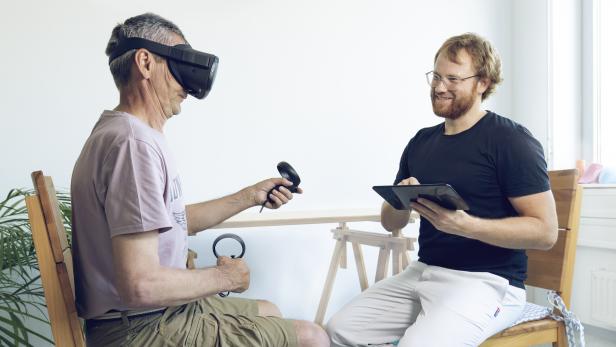The biggest motivation and reason why I chose to study design is to help people who are struggling with difficult life situations. Design makes it possible to be a supportive help to people, regardless of the medium. So this is why my chosen topic revolves around the condition Prosopagnosia or face blindness in combination with the use of VR. Prosopagnosia is an illness where an affected person cannot recognize the identities of other people.
Prosopagnosia
To go a little deeper into this illness and what it is about, there are actually about 2 percent of the population that have prosopagnosia – or face blindness. Due to this – inheritable – disease they cannot even recognise the face of their family members. To be able to live as normal as possible, they have certain tricks. To cover up the illness, they sometimes use their cell phone as a safety mechanism or are deeply engaged in a book. In the worst case, it can lead to social anxiety. Many affected people also learn certain characteristics of their counterpart, for example facial features, jewelry, height, skin color, body movement, weight and so on. However, if the person does not have any special characteristics to help them recognise, learning things like hair color or hair length or mouth or nose shapes do not really work, since a lot of the people look like a certain type. Affected people say that they are afraid to tell others about this illness. The reason behind it is, that they do not recognise others on the street and because of that they have this fear that it looks unfriendly or arrogant to others. If people with prosopagnosia are not in their familiar surroundings for a long time, it can happen that they do not even recognise people who are familiar to them at the beginning, because the features that they learned to recognise become blurred in their heads. So they are always wearing a mask to cover up their situation to not come across rude and not to hurt anyone, because people do not want to be forgotten. It makes people question their own worth and it makes them question the worth of the person with the condition because he or she couldn’t even take the time to remember this certain someones face.
Best Cases
The vision I have with this topic is to help somehow. So after I started thinking about how to approach this topic and which technology could be of help, I kept coming back to the topic of virtual reality. Nowadays, the use of VR or AR is becoming more and more popular in school, jobs or even in medicine. To mention a few companies who are interested in helping people with an illness, there is a start up company who want to help people with Prosopagnosia for example. They developed an AR App that reminds them, who the person in front of them is. The App functions in combination with smart glasses.

Another company uses VR, for example, to immerse people with disabilities, who are limited in their movements or can only perform certain actions, in a virtual world. Through this gamification, they automatically make larger movements than they would otherwise do. This is physically beneficial to them and they have fun because they can perform certain tasks and are therefore focused on solving them.

And there are a lot more of these kind of companies or ideas to help people. One company focuses on supporting people who have suffered a stroke. Learning or practicing with VR or AR helps to remember the information much easier and a lot faster.
My Vision
The problem I want to solve and the vision I have is to find a way or develop something to help this group of people and provide assistance from the beginning. Through this safe environment and of course the technology, the patient is not overwhelmed but can get used to the new situation at his own speed. Other advantages would be that the self-confidence is getting increased and the patient is perhaps a little better prepared to deal with the new situation in reality. I think that these technologies have a lot of advantages and can and should be used to help them in the best way possible.
This is a really well produced short film I found about Prosopagnosia:
Sources
- Die Zukunft der Arbeit/ AR und VR Trends für 2019 laut Experten, Vicki Lau (07.02.19), https://www.valamis.com/ de/blog/die-zukunft-der-arbeit-ar-und-vr
- Mit VR gegen die Angst/ Invirto bietet App-Therapie und Virtual Reality, Julius Beineke (03.02.20), https://t3n.de/news/ vr-gegen-angst-invirto-bietet-1248233/
- SocialRecall – Augmented Reality To Tackle Face-Blindness, Rebecca Hills-Duty (14.09.18), www.vrfocus.com/2018/09/augmented-reality-to-tackle-face-blindness/
- rewellio – Virtual Reality als neue Therapie für Schlaganfall-Patienten, Andrea Losa (27.12.19), https://futurezone.at/start-ups/virtual-reality-als-neue-therapie-fuer-schlaganfall-patienten/400705860
- WalkinVR – Virtual Reality for People with Disabilities, WalkinVRDriver (o.D.), https://www.walkinvrdriver.com
- TED Talk: VR Therapy, Unlocking the Potential of VR, Brian Boyle (22.10.19), http://www.youtube.com/watch?v=qxd-ppIDfjw
- Galileo: Mein Leben als Gesichtsblinde, Galileo (01.10.16), http://www.youtube.com/watch?v=bDGTKQAKHKY
- Prosopagnosia / Thriller Short Film, Hugo Keijzer (01.01.15), vimeo.com/129415238
- TED Talk: How being Face-Blind made it easier to see people, Fleassy Malay (16.02.19), https://www.youtube.com/watch?v=q3sZaoPQSc4